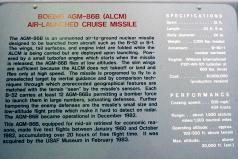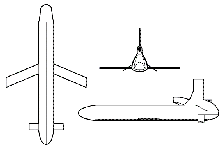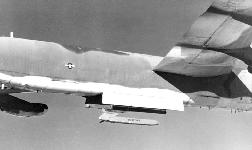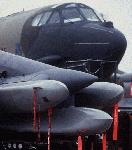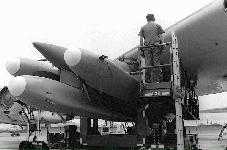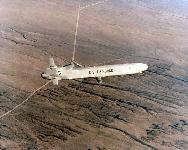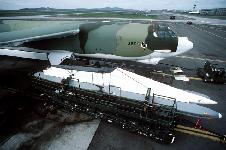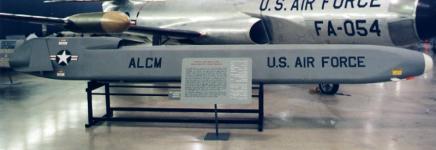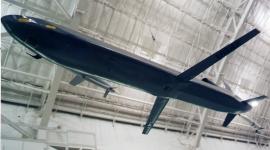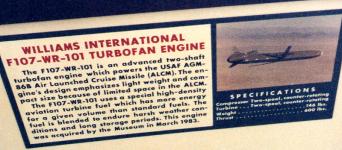AGM-86 Air-Launched Cruise Missile [ALCM]
The AGM-86B air-launched cruise missiles was developed to increase the effectiveness of B-52 bombers. The small, winged AGM-86B is powered by a turbofan jet engine that propels it at sustained subsonic speeds. After launch, the missile's folded wings, tail surfaces and engine inlet deploy. It then is able to fly complicated routes to a target through use of a terrain contour-matching guidance system. During flight, this system compares surface characteristics with maps of the planned flight route stored in on-board computers to determine the missile's location. As the missile nears its target, comparisons become more specific, guiding the missile to target with pinpoint accuracy.
The B-52 and the AGM-86B increase flexibility to attack targets. AGM-86B missiles can be air-launched in large numbers by the bomber force. The B-52H bombers carry six AGM-86B missiles on each of two externally mounted pylons and have been modified with a bomb bay rotary launcher for eight additional air-launched cruise missiles.
An enemy force would have to counterattack each of the missiles, making defense against them costly and complicated. The enemy's defenses are further hampered by the missiles' small size and low-altitude flight capability, which makes them difficult to detect on radar.The bomber's exposure to enemy defenses is reduced due to its extended range of effectiveness. Therefore, the missile may be launched with a large uncertainty in position, will independently navigate to the target, and initiate warhead detonation with a small Circular Error Probability (CEP).
Background
The weapon's concept was over a half-century old, but inadequate technology had prevented development of an effective missile. Two technical breakthroughs in the early 1970s transformed the concept into a practical weapon system. The first breakthrough came in computer technology, specifically a dramatic reduction in the physical size of computers coupled with equally dramatic increases in computer capabilities. These achievements fostered the development of a sophisticated guidance system that enabled the missile to fly at very low altitudes, making detection difficult. The second breakthrough, advances in propulsion, allowed engineers to decrease the missile's size while increasing its capabilities. The promise of a reliable and relatively inexpensive penetrating weapon system led to President Carter's 30 June 1977 announcement that the production of a B-1 bomber would be discontinued in favor of ALCM development.
The Air Force entered into a contract with Boeing Aerospace Company in February 1974 to develop and flight test a prototype ALCM (designated AGM-86A). The first ALCM powered flight took place on 5 March 1976 over the White Sands Missile Range in New Mexico when a B-52G crew ejected an ALCM from a SHAM rotary launcher. On 9 September 1976, the Air Force conducted the first fully-guided ALCM flight test. During the 30-minute flight, the ALCM successfully negotiated four terrain correlation mapped areas and completed a terrain correlation update in each area. The missile used in the flight tests was an AGM-86 "A" model which was slightly smaller than the the final production version, the AGM-86B. A production order was not placed for the Boeing model and by the time President Carter made his decision to proceed with the ALCM both Boeing and General Dynamics had developed cruise missiles. Boeing won a competitive flyoff between the two missiles and on 25 March 1980 received a contract to produce the AGM-86B.
Boeing delivered the first two ALCMs to the 416th Bombardment Wing, Griffiss AFB, New York, on 11 January 1981. These missiles were used initially by the wing for environmental testing and maintenance training. The first operational missile was assigned to the wing on 23 April 1981. On 15 August 1981, the 416th BMW received the first B-52G modified to carry the ALCM. The bomber could carry six missiles under each wing and had been outfitted with the Offensive Avionics System (OAS) to improve navigation and weapon delivery. The OAS replaced older analog computers and navigation components with a solid-state, digital system, which helped align, target, and launch the missiles. The first ALCM training flight was conducted on 15 September 1981 by the 416th BMW. On 21 September 1982, the 416th became the first operational wing to conduct an ALCM operational test launch, and on 16 December, the 416th was declared the first combat-ready ALCM-equipped wing. In July 1985, the 7th Bombardment Wing at Carswell AFB, Texas, became the first unit to receive ALCM-modified B-52H model bombers. A modified B-52H bomber could carry twenty ALCM missiles, six under each wing and eight mounted internally on a rotary launcher. By 23 August 1986, 98 B-52G aircraft had completed the cruise missile modification program. Boeing completed production of the 1,715th and last ALCM on 7 October 1986.
Specifications |
|
| Primary Function: | Air-to-surface strategic missile |
| Contractor: | Boeing Aerospace Co. |
| Guidance Contractors: | Litton Guidance and Control |
| Power Plant: | Williams Research Corp. F-107-WR-10 turbofan engine |
| Thrust: | 600 pounds (270 kilograms) |
| Length: | 20 feet, 9 inches (6.29 meters) |
| Weight: | 3,150 pounds (1,417.5 kilograms) |
| Diameter: | 24.5 inches (62.23 centimeter) |
| Wingspan: | 12 feet (3.64 meters) |
| Range: | AGM-86B: 1,500-plus miles (1,305 nautical miles) |
| Speed: | About 550 mph (Mach 0.73) |
| Guidance System: | Litton inertial navigation element with terrain contour-matching updates |
| Warheads: | Nuclear capable |
| Sensors: | A terrain contour-matching guidance system that allows the missile to fly complicated routes to a target through use of maps of the planned flight route stored in on-board computers |
| Unit Cost: | $1 million |
| Date Deployed: | December 1982 |
| Inventory: | Active force, 1,628; ANG, 0; Reserve, 0 |
